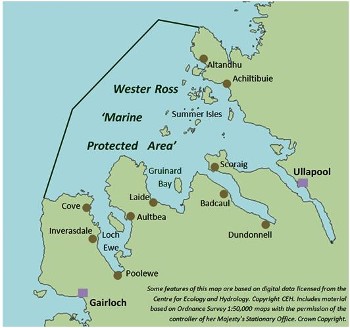Wester Ross Marine Protected Area: towards progressive management
Posted: Wednesday 20 August, 2014 @ 08:59:01

Following the designation of the Wester Ross Marine Protected Area [MPA] on 24th July 2014, attention has now moved towards management. Some local fishermen and other residents expressed surprise that following designation, contrary to expectations, scallop dredging will be allowed to continue over a large part of the MPA including most of Loch Ewe and Gruinard Bay for the forseeable future.
To help direct energy towards the challenge of developing more useful measures for nature conservation and to help restore more productive fisheries, please find a link here to a series of MPA management scenarios aimed at achieving the best outcomes for the MPA in the future. They are all summarised on one page (which should almost fit onto your computer screen).
http://www.wrft.org.uk/files/WRMPAmanagementscenarios19Aug2014.pdf
Please note that these are just ideas (other than Scenario 1)!
Scenario 1 is our starting point (as per 24th July 2014): seven relatively small voluntary protection zones around known maerl beds and flameshell beds have been outlined. However, larger areas of fragile seabed habitats within the MPA remain unprotected and vulnerable to further damage from dredgers.
Scenario 2: legal protection of the seabed for the whole of Loch Ewe, Gruinard Bay and other inner sea lochs, and around the Summer Isles. These areas would be off-limits to scallop dredging, promoting the recovery of many different types of complex seabed habitat and associated animals (a minimum target for June 2015?).
Scenario 3: legal protection of the seabed is extended to include shallow water habitats outside the sea lochs. At present, many of these areas remain inadequately surveyed: seabed habitats remain vulnerable. Even this scenario offers less protection for the seabed in coastal waters than existed prior to the removal of the ‘three-mile limit’ in 1985.
This scenario also proposes a licensing system to manage fishing effort. An inability to control the number of boats and creels led to the loss of Marine Stewardship Council ‘Sustainable Fishery’ accreditation for Loch Torridon nephrops fishery in 2011; and some scallop divers have suggested that too many scallops were taken by divers from some areas in the past.
Scenario 4 is more radical (for the next generation to consider?). It is offered to address the inherent global challenges for managing ‘wild-capture’ fisheries: competition between fishermen for limited resources and insecurity where the primary source of income for a fisherman is from sales of what he or she catches.
Under this scenario, fish harvesting rights are owned and controlled by a MPA management authority in partnership with local communities. Coastal waters are managed by sea-goers who earn salaries according to the jobs they do, which may include fisheries monitoring, harvesting and management. Stocks are managed to maximise their productive value at the same time as safeguarding associated habitats and other marine wildlife. The closest analogy I could think of is the Forestry Commission!
This scenario aims to replace traditional and now inappropriate ‘hunter-gatherer’ based fisheries where fishermen are in competition with each other, with something more akin to extensive aquaculture: crop production and collaboration. Fishing technology has progressed rapidly over the past 50 years; the capture and killing power of modern fishing boats means that without stringent regulation, prey species can be (and often have been) effectively ‘fished out’. What do you think?
Scenario 5: The MPA could be a testing ground for developing a management system to maximise the productivity of coastal waters and sustain many more jobs than there are at present.
Other scenarios could be developed, perhaps with small ‘sacred’ no-take zones like the Lamlash Bay no-take zone by Arran (following a campaign by the Community of Arran Seabed Trust [COAST]), or the fish conservation zones in the Mekong River (which I helped with in the 1990s!) where local people help to look after the fishes and other animals which live in the waters around them; who knows what may be possible?
Note that Marine Scotland is to lead the development of management measures within the MPA. Think positively: help Marine Scotland protect and manage our coastal seas in the best long-term interests of people living in Scotland.
Peter Cunningham, info@wrft.org.uk